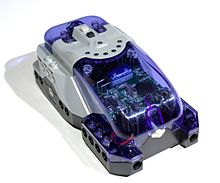Lego Spybotics
Lego Spybotics (official spelling: LEGO Spybotics) is a product series of the Lego Company, the 2002 models with the names Gigamesh G60 (Lego no.3806 ), Snaptrax S45 (3807), Shadowstrike S70 (3808) and Technojaw T55 (3809) has presented. The Spybotics were only sold for a short time, in 2008 all support from Lego was discontinued.
properties
The kits each contain a programmable Lego brick with two electric motors , a touch and light sensor as well as Lego Technic elements ( gears , axes, perforated bars, etc.) to construct one of the four Spybotics robots . The built-in motors and sensors as well as the supplied software distinguish the Spybotics series from the RCX brick from the Lego Mindstorms product series , to which up to three motors and three sensors can be connected externally.
The Spybotics models and their preset properties, which can be derived from the various drive systems:
| Model → Property ↓ |
TECHNOJAW T55 | SNAPTRAX S45 | SHADOWSTRIKE S70 | GIGAMESH G60 | ||||||||||||||||||||||||||||
| speed |
|
|
|
|
||||||||||||||||||||||||||||
| Strength |
|
|
|
|
||||||||||||||||||||||||||||
| agility |
|
|
|
|
programming
The programmable Lego brick from Spybotics can be programmed in various programming languages just like the RCX brick . To do this, the program is written on the PC , compiled and then loaded onto the Spybotics using a VLL interface (connection with visible light). Then the Spybotics can act completely autonomously and react to external and internal events, according to the programming instructions. With the help of an infrared remote control, you can take control of the motors at any time or trigger another event.
In addition, Spybotics can communicate with each other via the infrared interface in order to be able to carry out a mission together. To do this, each Spybotic sends out an infrared message, the so-called ping, several times per second . Every other Spybotic within range automatically processes the pings and stores the information on up to 16 other Spybotics or remote controls in the so-called World Table . The information about every other Spybotics can be called up via special variables from the world table:
| Name of the variable | meaning | Range of values |
|---|---|---|
| SPY_NOTE | Own note about this station | 0-255 |
| SPY_LINKID | Remote control that this Spybot is connected to | 0-7 (0 means: not connected to a remote control) |
| SPY_RANGE | Distance of the transmitter | Nowhere (0), anywhere (1), there (2), here (3) |
| SPY_DIRECTION | Direction of the sender | Left (0), Center left (1), Center (2), Center right (3), Right (4) |
| SPY_ASPECT | Orientation of the transmitter to the receiver | Front Left (0), Front (1), Front right (2), Back Right (3), Back (4), Back Left (5) |
| SPY_INFO | Message from the sender | 0-255 |
| SPY_SHORTID | Identification of the sender | 0-255 |
Programming languages for Lego Spybotics
Basically, the Spybotics can be programmed just like the RCX. More information on programming languages can be found there. With the BricxCC software, the content of the internal EEPROM of the Spybotic can also be read and changed.
A simple program for the Spybotic in the NQC programming language could look like this:
task main()
{
OnFwd(OUT_A+OUT_B); //Schalte die Motoren (Output A + Output B) ein
Wait(400); //Warte 4 Sek.
Off(OUT_A+OUT_B); //Schalte die Motoren (Output A + Output B) aus
}
Every program in this programming language should begin with task main . OnFwd (OUT_A + OUT_B) means that the two built-in motors (motor A and B) rotate in the forward direction. A statement ends with a semicolon . A Wait instruction simply means that the program waits the specified time - a multiple of 10 ms - and only then continues with the next command. In this example both motors rotate for 4 seconds and are then stopped with the command Off .
There are special NQC extensions for the Spybotics with which you can use their properties in the program. For example, the command FindWorld (index, SPY_RANGE, REL_GT, RANGE_NOWHERE) can be used to find the next entry in the world table from which a ping was received. The associated line is returned in the variable index, via which all available information can then be accessed. This makes it possible to program complex interactions among the Spybots, e.g. B. Herd or swarm behavior or predator - prey behavior.
Web links
- Lugnet Robotics - Community of Lego Mindstorms & Co. (English)
- Smart Parts - The Unofficial Spybotic Resource Center (English)
Individual evidence
- ↑ Spybotics FAQ , website, last visited on August 9, 2015
- ↑ a b Swarm Tutorial ( page no longer available , search in web archives ) Info: The link was automatically marked as defective. Please check the link according to the instructions and then remove this notice. , Website, last visited on August 9, 2015
- ↑ a b Robots can also rave , Make 2/2015, Heise-Verlag, 2015, pp. 66–73

